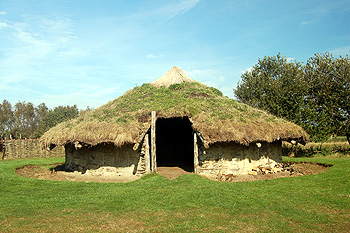Prehistoric Toddington

A reconstruction of an Bronze Age round house at Flag Fen October 2011
A prehistoric trackway known as the Thiodweg or Theedway [HER10843] branches off from the Icknield Way north of Luton and runs through the south of Toddington parish towards Leighton Buzzard where it crossed the River Ousel at Yttingaford (now Tiddenfoot). The origins of this track are unknown but it is probably Neolithic. Theedway was linked to salterns on the East Anglian fen edges and became a major route for transporting salt in Saxon and earlier medieval times. Parts of the track are shown on the Agas map of 1581, and the section near Chalton was known as the Old Salt Way.
The Bedfordshire Historic Environment Record [HER] contains information on the county's historic buildings and landscapes and summaries of each entry can now be found online as part of the Heritage Gateway website. A number of prehistoric flints have been found in Toddington, dating from the Mesolithic, Neolithic and Bronze Age periods. Bronze Age finds include two nearly complete urns found off Leighton Road to the south-west of the parish in 1881 [HER1426], a metalworker's hoard at Park Close to the north-west [HER1512] and a socketed axe with two copper spearheads at Cowbridge to the east [HER94]. Other finds have been made in the hamlets of Fancott and Chalton. This places Toddington near the centre of a concentration of Bronze Age finds unrivalled elsewhere in Bedfordshire. There are vague references to a possible Bronze Age burial mound in a field to the north of the town [HER3635] and a possible barrow on the highest point of Toddington [HER11774].
In the 19th century an Iron Age coin of Cunobelin was found at an unrecorded location in Toddington [HER14736]. He was the leader of the powerful Catuvellauni tribe who had their base in what is now Hertfordshire and Bedfordshire and who seem to have dominated much of southern Britain.
An archaeological survey prior to the M1 widening scheme revealed an Iron age site near Chalton Cross Farm. Activity on this site appears to be of early to middle Iron Age date. Later activity on the site dates to the Romano-British period [HER15839]